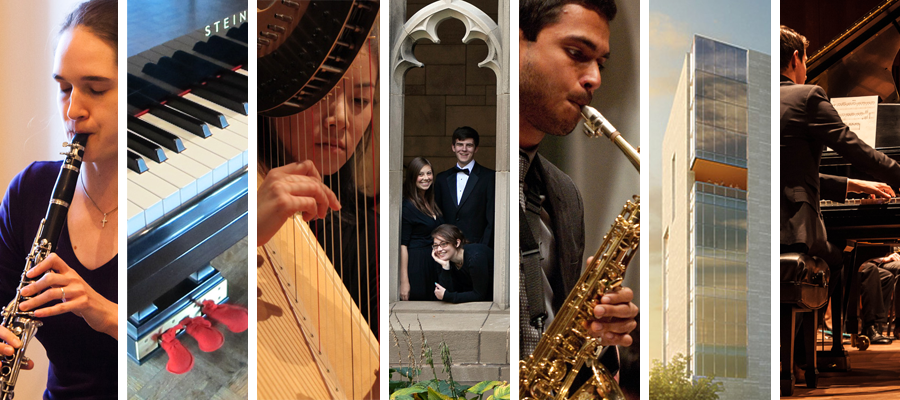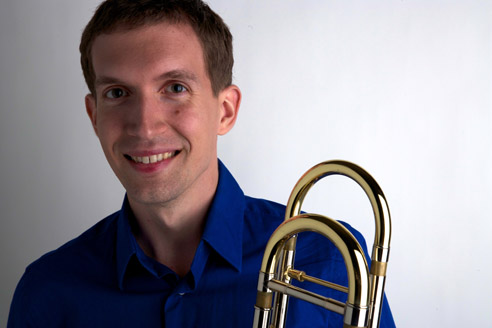Interview with University Brass Ensemble director Tom Kociela for the ensemble’s Spring Concert, “Sounds of Brass,” this Sunday, May 26th at 4:00pm in Fulton Recital Hall. Tell us what we can expect from this upcoming program.
The concert opens with music by Wagner from the opera Lohengrin. We then perform an exciting allegro vivace movement by Eric Ewazen, who is always a big hit with audiences. Other highlights include two movements from a demanding new work by Bruce Broughton, and a piece by David Uber, which includes sounds reminiscent of the old television recording studios. Each piece is very distinct and almost everything on the program was written specifically for brass. That is why I’ve titled the concert “Sounds of Brass.” I hope that everyone reading this will consider coming out on Sunday!
Looking back at your first year as Director of this ensemble, what changes have you seen? How has this ensemble grown?
This year has been one of great progress. I am very proud of the entire ensemble and the fact that the performance level continues to increase. The improvement from our first concert to the second was noticeable to everyone involved and to repeat audience members.
Listening closely to others and an enhanced awareness of note shapes are my main musical objectives for the ensemble. I am absolutely insistent on these two points because without them the end product is unconvincing and barely cohesive. Only when everyone is listening and willing to adjust can the end product be convincing. My whole approach is about context and consideration of others at all times. As for note shapes, well, the ensemble knows exactly what I mean and what a huge difference this makes. Each note must begin immediately and then there is usually some amount of taper in the middle of the note, maybe just a little or quite a bit – the context helps to determine this. When the entire ensemble commits to clear playing and constant adjustment the resulting product is very professional. I am happy to report that this is all happening more frequently as the weeks’ progress, but you will have to come hear for yourself.
Looking ahead, what future goals do you have for this ensemble? Is there any particular repertoire that you are working up to?
I would like for the UC Brass Ensemble to be a welcome place for any brass player on campus. It is open to anyone who is willing to make the commitment and take time to do what I am asking. I made a decision to allow each member to play first parts as well as solos and I think that these opportunities have made everyone more aware of how their part fits into the larger picture. This ensemble is about improvement, raising one’s standards and having a good time performing great pieces of music.
I have a wish list of pieces but repertoire for repertoire’s sake isn’t my end goal. I choose pieces that challenge the ensemble in specific musical ways. Our first concert included music that allowed me to promote clear playing and careful listening. The second was more about creating a singing sound. We are currently rehearsing works with greater technical demands. The performance program at U of C is so strong and diverse, I want for the brass players to bring these skills to their other ensembles.
Audience members who attend UC Brass Ensemble concerts experience more than the music. You have been known to speak directly to the audience, providing anecdotes about each piece, occasionally asking the ensemble to demonstrate excerpts of a given piece for greater clarity and even ask the audience to participate in interactive demonstrations! How do you think this enhances the audience’s as well as the students’ experience?
I believe that as musicians we must promote our music in many ways. Program notes can surely help, but a little collective laughter goes a long way towards making the overall experience memorable. There is an invisible barrier between the audience and the musicians, I would rather that there be no barrier!
I like to break apart and explain unusual chord progressions, sonorities, and rhythmic material. Sometimes the audience can sing or clap along to the demonstration. This is very welcoming and allows them to experience an aspect of the music that may otherwise go by unnoticed. A fun fact or casual observation about the work to be performed often causes audience members to listen with greater interest.
As a professional performer in your own right, having played trombone with the Chicago Symphony Orchestra, among many others, and shared the stage with some of the biggest names in Classical music today, which performances are you most looking forward to in the coming season?
I wish that I knew! Most orchestral gigs are contracted less than a month before the performance but I always end up with some fun parts to play throughout the year. In addition to trombone I play euphonium and bass trumpet, so I find myself with opportunities when those instruments are required. The freelance life is rarely consistent and I have made it work by doing things that are a bit steadier. I find private teaching and other directing opportunities to be incredibly rewarding. My small business, TKBB Press recently released a book and CD called The Intonation Repair Tool, which is all about listening and adjusting. It has been very successful thus far and we have begun to visit colleges and school programs to discuss intonation and careful listening in ensemble performance.
I truly enjoy the collaborative aspect of performance and will continue to pursue those opportunities. More and more I am pulled towards improving music education. I believe that thoughtful music education benefits the entire arts community and the public alike.
It is a pleasure to be part of the performance program here at U of C. I hope to see everyone on Sunday!
Interview by Julia Tobiska

